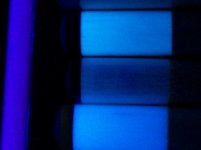Pictures of Ivory Under UV Light...
Does anyone have any to post up?
I'm looking through some of my cues with claimed ivory ferrules and checking them out under a black light. I also started checking out my other shafts with non-ivory ferrules, and I'm mystified by my findings.
Researching google, and the AZ archives will explain that genuine ivory and a number of ivory alternatives will become fluorescent under UV light. Unfortunately there is little to no images online that help identify the characteristics of each material for the purpose distinguishing genuine from the synthetics and how to identify each synthetic alternative.
I'm taking a few right now, if I can get the focus right, I'll have some up shortly.
Does anyone have any to post up?
I'm looking through some of my cues with claimed ivory ferrules and checking them out under a black light. I also started checking out my other shafts with non-ivory ferrules, and I'm mystified by my findings.
Researching google, and the AZ archives will explain that genuine ivory and a number of ivory alternatives will become fluorescent under UV light. Unfortunately there is little to no images online that help identify the characteristics of each material for the purpose distinguishing genuine from the synthetics and how to identify each synthetic alternative.
I'm taking a few right now, if I can get the focus right, I'll have some up shortly.










